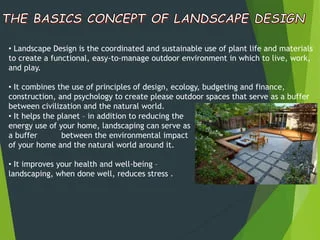3 Easy Facts About Landscape Design Explained
3 Easy Facts About Landscape Design Explained
Blog Article
More About Landscape Design
Table of ContentsFacts About Landscape Design RevealedSome Known Questions About Landscape Design.4 Simple Techniques For Landscape DesignA Biased View of Landscape Design
When making a property landscape, one of the most important step is to place a strategy on paper. Developing a plan of attack will certainly save you money and time and is most likely to result in a successful layout. Landscape Design. A plan of attack is established with the 'layout procedure': a detailed approach that takes into consideration the ecological problems, your needs, and the aspects and concepts of layoutThe five actions of the design process consist of: 1) performing a website inventory and evaluation, 2) determining your requirements, 3) creating practical diagrams, 4) establishing conceptual style plans, and 5) drawing a final design plan. The very first 3 actions establish the aesthetic, practical, and gardening requirements for the layout. The last 2 actions after that use those demands to the production of the last landscape strategy.
This is a critical step for both plant choice and positioning and finding household tasks and features. It's important since the exact same environment problems that impact the plantstemperature, humidity, rain, wind, and sunlightalso influence you, the customer. The next step is to make a list of your demands and desiresthis aids you establish just how your backyard and landscape will certainly be made use of.
The functional layout is then made use of to find the task spaces on the site and from this representation a theoretical strategy is developed - Landscape Design. The last action is a final design that includes all the hardscape and growing information that are required for setup. Throughout the design procedure there are 10 vital things to consider: for plant option and activity area by considering what you desire and need to aid determine forms and organize rooms by marking activity locations and relating to elements for both the setting and the individual by utilizing massing and layering methods such as transition locations and focal factors in the materials, the shades, and the surface area structures for the development and maintenance of plants by making use of lasting design techniques A thorough inventory and analysis of the site is very important to determine the ecological conditions for plant growth and the best use of the website
The Ultimate Guide To Landscape Design
The kind of dirt determines the nutrients and wetness readily available to the plants. It is always best to use plants that will certainly flourish in the existing dirt. Dirt can be modified, amendment is typically pricey and the majority of times inadequate. Existing greenery can give ideas to the dirt type. Where plants expand well, keep in mind the dirt problems and make use of plants with comparable expanding needs.

Sun/shade patterns, the quantity and size of exposure to sunlight or color (Number 1), create microclimates (often called microhabitats). Recording site conditions and existing vegetation on a base map will certainly disclose the area of microclimates in the backyard. Plants normally fall under a couple of of 4 microclimate categories-full sunlight, partial shade, color, and deep color.
Figure 1. Sunlight and shade patterns. Credit: Gail Hansen, UF/IFAS It is vital to keep in mind all the status quo on an exact base map when doing the website stock (Number 2). Landscape Design. Energies such as high-voltage line, sewage-disposal tanks, below ground i thought about this energies and roof covering overhangs establish plant place. Utilize a property surveyor's plat of your building for the borders and area of your home.
The 8-Minute Rule for Landscape Design
Budget plan concerns consist of the materials, initial installment costs and the on-going maintenance expenses. Establish the moment and cash you agree to place into keeping the plants and hardscape-be realistic about your intentions and capability. Figure 3. Current usage areas. Debt: Gail Hansen, UF/IFAS Figure 4. Proposed usage locations. Credit Report: Gail Hansen, UF/IFAS There are numerous different landscape design motifs- from easy to complex, however it is practical to select one to guide your plant and product option.

Make a decision if you desire to open your lawn, shut your lawn, or a little of both, to these views. To put it simply, do you want the garden to enclose the space around you and relate mostly to the house, or do you want the garden to open views and look outward, connecting to the surroundings? This will certainly provide you a beginning factor to think of a theme.
The Only Guide for Landscape Design

This is called "sense of place", which suggests it fits with the environments. There are both type motifs and design themes. Every garden needs to have a kind style, but not all gardens have a design theme. Many domestic yards have no specific design except to blend with the residence by repeating details from the architecture such as materials, shade, and form.
In a form motif the organization and form of the spaces in the yard is based either on the form of your basics home, the shape of the locations between the home and the property borders, or a preferred form of the house owner. The kind style figures out the form and organization (the design) of the spaces and the web links between them.

Report this page